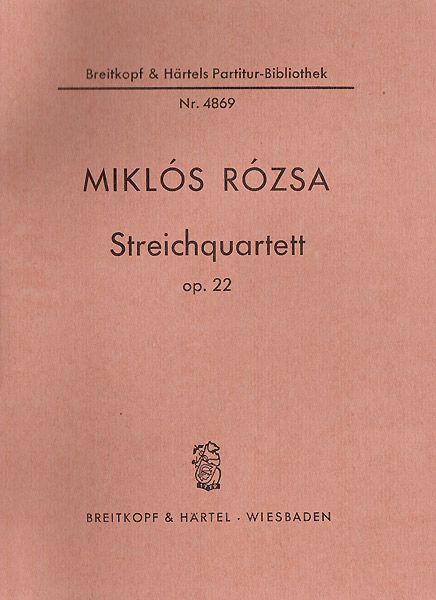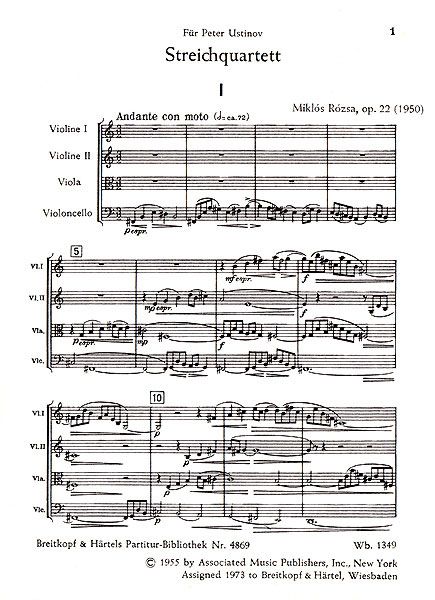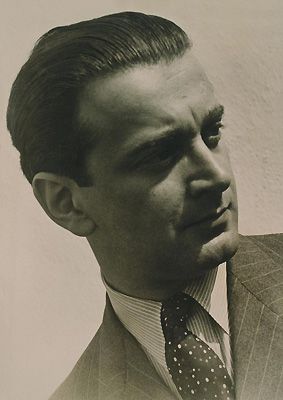wimpel69
03-12-2013, 02:47 PM
I am a great admirer of American-Hungarian composer Mikl�s R�zsa, whose
music for Ben-Hur, El Cid, King of Kings and other epics, adventure films and
film noirs is certainly familiar to all of you who love good music in films.
However, through intensive and extended analysis of his body of work I have come
to realize that I regard an intimate chamber work, the String Quartet op.22
(later String Quartet No.1, op.22) as probably his most distinguished piece,
ahead of the more extrovert film music and the Violin or Viola Concertos.
R�zsa composed his (first) String Quartet on his return voyage from Rome in
1950, where he visited the filming of Quo Vadis?, which he was contracted
to score (it was the first of his "epic" scores). As an antidote to the vast orchestral
canvasses he had to provide in the film score, he composed an intimate (but dynamic)
quartet which he dedicated "for Peter Ustinov", whom he had befriended during
his stay in Rome (Ustinov said that he would dedicate his next play to R�zsa in return
- but he never did).
This upload includes all three commercially available recordings of this quartet
(not the additional works listed on the album covers!), in FLAC, plus my own scan of the
complete score, published by Breitkopf & H�rtel, in PDF format.
The link is down. No more requests, please!





Music Composed by Mikl�s R�zsa
Score publisher: Breitkopf & H�rtel, Wiesbaden, Germany
"After spending months working on the grand score for the film Quo Vadis, his first Biblical epic, R�zsa must have
sought something pure and cleansing when turning for the first time to the string quartet medium. In his concert works,
R�zsa never attempted formal innovation. He was a master of the classical structures, as is clear from the technical
facility of this first quartet. The opening movement, Andante con moto, is in sonata form. The two main subjects
could hardly be more dissimilar: a noble, lyrical utterance from the cello (soon taken up by the other instruments),
versus some sharply argumentative fugal material. The development is predictably spirited, but the movement reaches
a calm ending. A false comfort, perhaps, before the jagged Vivo capriccioso movement, a "Scherzo in modo ongarese."
In a percussive 5/8 rhythm, the movement is an almost Bart�kian Hungarian dance; during the strongly accented
second theme, reminiscent of Hungarian peasant music, the pizzicato viola imitates the cimbalom. This movement
trails off to make way for the elegiac third movement, Lento. The atmosphere is impressionistic and nocturnal,
with the sweet yearning R�zsa so often introduced into his slow movements. The passion builds slowly to a small
midpoint climax (employing fragments of the quartet's opening theme), but the music soon falls away to its initial
mood. The finale is aptly called Allegro feroce. It's a sonata-rondo, and its brutal ritornello material seems all the
more primitive for using open strings. Twice the ferocity subsides into slow sections that feature solos by the
cello and violins. Before it's all over, R�zsa also manages to work in the first movement's opening theme again,
threading it into the boisterous contrapuntal argument that brings the work to a typically vigorous conclusion."
All Music

Source: Vox Box, Laurel Records* + ASV* (*my rips)
Format: FLAC (compression level: -5), PDF (score)
File Size: 375 MB
The link is down. No more requests, please!
Enjoy! Don't share! Buy the originals! :)
music for Ben-Hur, El Cid, King of Kings and other epics, adventure films and
film noirs is certainly familiar to all of you who love good music in films.
However, through intensive and extended analysis of his body of work I have come
to realize that I regard an intimate chamber work, the String Quartet op.22
(later String Quartet No.1, op.22) as probably his most distinguished piece,
ahead of the more extrovert film music and the Violin or Viola Concertos.
R�zsa composed his (first) String Quartet on his return voyage from Rome in
1950, where he visited the filming of Quo Vadis?, which he was contracted
to score (it was the first of his "epic" scores). As an antidote to the vast orchestral
canvasses he had to provide in the film score, he composed an intimate (but dynamic)
quartet which he dedicated "for Peter Ustinov", whom he had befriended during
his stay in Rome (Ustinov said that he would dedicate his next play to R�zsa in return
- but he never did).
This upload includes all three commercially available recordings of this quartet
(not the additional works listed on the album covers!), in FLAC, plus my own scan of the
complete score, published by Breitkopf & H�rtel, in PDF format.
The link is down. No more requests, please!





Music Composed by Mikl�s R�zsa
Score publisher: Breitkopf & H�rtel, Wiesbaden, Germany
"After spending months working on the grand score for the film Quo Vadis, his first Biblical epic, R�zsa must have
sought something pure and cleansing when turning for the first time to the string quartet medium. In his concert works,
R�zsa never attempted formal innovation. He was a master of the classical structures, as is clear from the technical
facility of this first quartet. The opening movement, Andante con moto, is in sonata form. The two main subjects
could hardly be more dissimilar: a noble, lyrical utterance from the cello (soon taken up by the other instruments),
versus some sharply argumentative fugal material. The development is predictably spirited, but the movement reaches
a calm ending. A false comfort, perhaps, before the jagged Vivo capriccioso movement, a "Scherzo in modo ongarese."
In a percussive 5/8 rhythm, the movement is an almost Bart�kian Hungarian dance; during the strongly accented
second theme, reminiscent of Hungarian peasant music, the pizzicato viola imitates the cimbalom. This movement
trails off to make way for the elegiac third movement, Lento. The atmosphere is impressionistic and nocturnal,
with the sweet yearning R�zsa so often introduced into his slow movements. The passion builds slowly to a small
midpoint climax (employing fragments of the quartet's opening theme), but the music soon falls away to its initial
mood. The finale is aptly called Allegro feroce. It's a sonata-rondo, and its brutal ritornello material seems all the
more primitive for using open strings. Twice the ferocity subsides into slow sections that feature solos by the
cello and violins. Before it's all over, R�zsa also manages to work in the first movement's opening theme again,
threading it into the boisterous contrapuntal argument that brings the work to a typically vigorous conclusion."
All Music

Source: Vox Box, Laurel Records* + ASV* (*my rips)
Format: FLAC (compression level: -5), PDF (score)
File Size: 375 MB
The link is down. No more requests, please!
Enjoy! Don't share! Buy the originals! :)